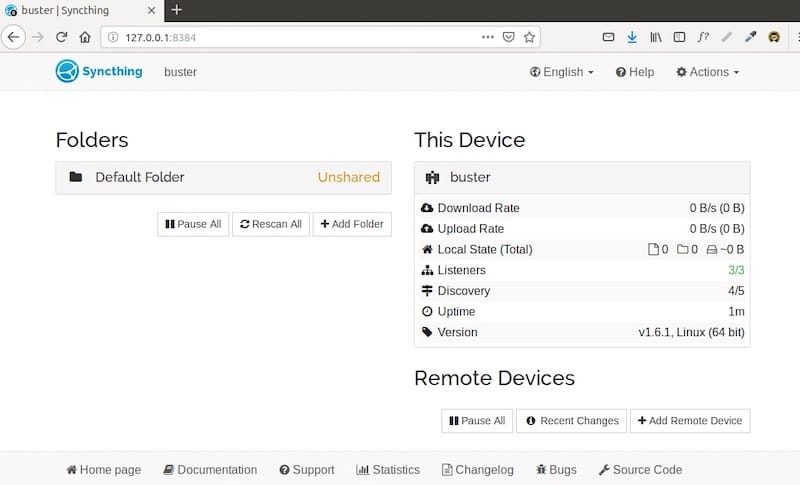How To Install Syncthing on Fedora 41

Syncthing is a powerful, open-source, continuous file synchronization tool that allows you to keep files synchronized between two or more computers in real time, safely protected from prying eyes. Unlike cloud-based solutions, Syncthing operates on a decentralized peer-to-peer network, meaning your data is stored only on your devices, giving you complete control over your information. This guide provides detailed, expert-driven methods for deploying Syncthing on Fedora 41, emphasizing security, flexibility, and performance optimization.
This comprehensive guide will walk you through various installation methods, initial configuration, security hardening, and troubleshooting to ensure a smooth and efficient setup. Whether you’re a seasoned Linux user or new to Fedora, this article will provide all the necessary steps to get Syncthing up and running on your system.
Why Choose Syncthing?
- Privacy and Security: Your data is your data alone. There is no central server that might be compromised. All communication is secured using TLS encryption.
- Decentralization: No third-party servers are involved, enhancing privacy and ensuring your data remains under your control.
- Cross-Platform Compatibility: Syncthing supports Windows, Linux, FreeBSD, and Android, making it a versatile solution for syncing files across your entire digital ecosystem.
- Open Source: The code is freely available for anyone to inspect and audit, ensuring transparency and community-driven improvements.
1. Introduction to Syncthing and Fedora 41 Compatibility
Syncthing is a continuous file synchronization program that synchronizes files between two or more computers in real-time, protected from prying eyes. It operates on a peer-to-peer network, allowing users to securely sync and share files across multiple devices. Fedora 41, the latest release of the Fedora operating system, provides an excellent platform for deploying Syncthing, thanks to its updated package repositories and systemd integration.
- Decentralized Architecture: Syncthing’s decentralized nature ensures that your data is not stored on any third-party servers, giving you full control over your information.
- Cross-Platform Support: Syncthing supports various operating systems, including Windows, Linux, and mobile devices, making it a versatile solution.
- Fedora 41 Enhancements: Fedora 41’s updated package repositories and systemd integration make the deployment of Syncthing seamless.
2. Prerequisites for Installation
Before you begin, ensure you have the following:
- Fedora 41 System: A running Fedora 41 system with sudo or root access is required.
- Internet Connection: An active internet connection is necessary for downloading packages.
- Terminal Proficiency: Basic familiarity with the Linux terminal is needed for executing commands.
3. Method 1: Installing Syncthing via Fedora Repositories
The easiest way to install Syncthing on Fedora 41 is through the official Fedora repositories. This method ensures you get a stable and tested version of Syncthing that integrates well with your system.
3.1. Updating System Packages
Before installing any new software, it’s always a good practice to update your system’s package list. This ensures you have the latest versions of all installed packages and their dependencies.
- Open the terminal.
- Type the following command and press Enter:
sudo dnf updateThis command updates all packages to their latest versions.
- Validating GPG Keys: DNF automatically validates the GPG keys of the packages to ensure their integrity.
- Metadata Integrity: The metadata of the repositories is also checked to prevent any tampering.
3.2. Installing the Official Syncthing Package
Once the system is updated, you can install the Syncthing package from the Fedora repositories.
- In the terminal, type the following command to search for the Syncthing package:
dnf search syncthing- After locating the package, install it using the following command:
sudo dnf install syncthing- To verify the installation, check the Syncthing version:
syncthing --version3.3. Enabling and Starting the Systemd Service
To ensure Syncthing runs automatically in the background, you need to configure it as a systemd service.
- Create a dedicated user account for Syncthing. This enhances security by ensuring Syncthing runs with minimal privileges:
sudo useradd -m -s /bin/false syncthing- Configure the
syncthing@<username>.servicefile for user-level operation. This involves creating a copy of the default service file and modifying it:
sudo cp /usr/lib/systemd/system/syncthing@.service /etc/systemd/system/syncthing@syncthing.service- Edit the service file to reflect the correct user:
sudo nano /etc/systemd/system/syncthing@syncthing.serviceModify the User= line to:
User=syncthing- Enable and start the Syncthing service:
sudo systemctl enable syncthing@syncthing.service
sudo systemctl start syncthing@syncthing.service- To enable autostart, use the following command:
systemctl --user enable --now syncthing.service4. Method 2: Manual Installation from Official Binaries
For those who prefer more control over the installation process or need the latest version of Syncthing, manual installation from official binaries is an excellent option.
4.1. Downloading the Latest Release
The first step is to download the latest Syncthing binary from the official GitHub releases page.
- Open the terminal.
- Use
wgetto retrieve the AMD64 binary:
wget https://github.com/syncthing/syncthing/releases/latest/download/syncthing-linux-amd64-v1.28.1.tar.gz- Validate the checksum to ensure file integrity:
sha256sum syncthing-linux-amd64-v1.28.1.tar.gzCompare the output with the checksum provided on the Syncthing releases page.
4.2. Extracting and Deploying the Binary
After downloading the binary, extract it and move it to a directory in your system’s PATH.
- Extract the tarball:
tar -xzf syncthing-linux-amd64-v1.28.1.tar.gz- Move the
syncthingbinary to/usr/local/bin:
sudo mv syncthing /usr/local/bin/- Make the binary executable:
sudo chmod +x /usr/local/bin/syncthing4.3. Configuring Systemd for Persistent Operation
To run Syncthing as a service, you need to create a custom service file in /etc/systemd/system/.
- Create the service file:
sudo nano /etc/systemd/system/syncthing.service- Add the following content to the file:
[Unit]
Description=Syncthing - Open Source Continuous File Synchronization
After=network.target
[Service]
User=yourusername
ExecStart=/usr/local/bin/syncthing -no-browser -logfile=/var/log/syncthing.log
Restart=on-failure
RestartSec=5
LimitNOFILE=65536
[Install]
WantedBy=multi-user.targetReplace yourusername with your actual username.
- Reload the systemd daemon:
sudo systemctl daemon-reload- Enable and start the Syncthing service:
sudo systemctl enable syncthing.servicesudo systemctl start syncthing.service- Troubleshooting SELinux Context Issues: If you encounter issues, check SELinux logs and adjust the context accordingly.
5. Method 3: Installing via Snap Package
Snap packages provide a convenient way to install Syncthing with automatic updates and dependency management.
5.1. Enabling Snap Support on Fedora 41
Before installing Syncthing via Snap, you need to enable Snap support on your Fedora 41 system.
- Install
snapd:
sudo dnf install snapd- Enable the Snapd service:
sudo systemctl enable --now snapd- Create a symbolic link for classic Snap support:
sudo ln -s /var/lib/snapd/snap /snap5.2. Deploying the Syncthing Snap
With Snap support enabled, you can now install the Syncthing Snap package.
- Install Syncthing using the following command:
sudo snap install syncthing-arubislander- Manage autostart with the following command:
syncthing-arubislander.enable-autostart5.3. Security Considerations for Snap Confinement
Snap packages are confined, which enhances security but may limit access to certain system resources.
- Review Snap permissions with the following command:
snap connections syncthing-arubislander6. Initial Configuration and Device Pairing
After installing Syncthing, you need to configure it and pair it with other devices to start synchronizing files.
6.1. Accessing the Web Interface
Syncthing provides a web-based interface for configuration and management.
- Open your web browser and navigate to:
http://localhost:8384- Generate a strong password for the GUI admin panel for security.

6.2. Adding Remote Devices
To synchronize files with another device, you need to add it as a remote device.
- Exchange device IDs via QR codes or manual entry.
- Configure shared folders with conflict resolution policies.
6.3. Bandwidth and Versioning Settings
Optimize Syncthing’s performance by adjusting bandwidth and versioning settings.
- Throttle sync speeds during peak hours to avoid network congestion.
- Enable staggered file versioning for data recovery.
7. Security Hardening and Best Practices
To ensure Syncthing is secure, follow these best practices.
7.1. Firewall Configuration with Firewalld
Configure the firewall to allow Syncthing traffic.
- Allow TCP ports 22000 (sync) and 8384 (GUI) via
firewall-cmd:
sudo firewall-cmd --add-port=22000/tcp --permanent
sudo firewall-cmd --add-port=8384/tcp --permanent
sudo firewall-cmd --reload7.2. Disabling Global Discovery for Sensitive Deployments
For sensitive deployments, disable global discovery to restrict peer-to-peer discovery.
- Edit
config.xmlto restrict peer-to-peer discovery.
7.3. Regular Updates via DNF
Keep Syncthing updated to mitigate potential security vulnerabilities.
- Automate patches with
dnf-automaticfor CVE mitigation.
8. Troubleshooting Common Issues
Even with careful setup, you may encounter issues. Here are some common problems and their solutions.
8.1. Diagnosing Service Failures
If Syncthing fails to start, check the logs.
- Inspect logs via
journalctl --user-unit syncthing.service.
8.2. Resolving File Permission Conflicts
File permission issues can prevent Syncthing from syncing files.
8.3. Handling NAT Traversal Limitations
Devices behind restrictive firewalls may have trouble connecting.
- Configure relay servers for devices behind restrictive firewalls.
9. Advanced Usage and Automation
Once Syncthing is running smoothly, you can explore advanced features.
9.1. CLI Management with syncthing cli
Use the command-line interface for advanced management.
- Script bulk folder additions via JSON configuration.
9.2. Integrating with Cron for Scheduled Syncs
Automate synchronization tasks with cron.
- Trigger manual syncs during low-usage periods.
9.3. Backup Strategies with Btrfs Snapshots
If you use the Btrfs file system, leverage its snapshot capabilities for backups.
- Leverage CoW features for point-in-time recovery.
Troubleshooting Snap Packages
If you encounter issues with Snap packages on Fedora 41, consider the following troubleshooting steps:
- Ensure Snapd is enabled and running:
systemctl status snapd- Check for Snap-related errors:
snap refresh- If you encounter mount errors, it may be related to SELinux policies.
Securing Syncthing
In addition to the security best practices mentioned earlier, consider the following to further secure your Syncthing installation:
- Use Strong Passwords: Ensure your Syncthing web GUI is protected with a strong, unique password.
- Enable HTTPS: Use HTTPS for secure communication with the web GUI.
- Monitor Device Connections: Regularly review connected devices to ensure only trusted devices are syncing with your system.
Automating Syncthing with Systemd Timers
Systemd timers can be used to automate tasks such as restarting Syncthing or running maintenance scripts. Here’s an example of how to create a systemd timer to restart Syncthing daily:
- Create a new timer unit file:
sudo nano /etc/systemd/system/syncthing-restart.timer- Add the following content:
[Unit]
Description=Restart Syncthing Daily
[Timer]
OnCalendar=*-*-* 00:00:00
Persistent=true
[Install]
WantedBy=timers.target- Create a service unit file:
sudo nano /etc/systemd/system/syncthing-restart.service- Add the following content:
[Unit]
Description=Restart Syncthing
[Service]
Type=oneshot
ExecStart=systemctl restart syncthing.service- Enable and start the timer:
sudo systemctl enable syncthing-restart.timer
sudo systemctl start syncthing-restart.timerSELinux Considerations
Fedora uses SELinux for enhanced security. If you encounter issues with Syncthing, it may be related to SELinux policies. Here’s how to troubleshoot:
- Check SELinux logs:
sudo ausearch -m avc -ts recent- If SELinux is blocking Syncthing, you can create custom policies to allow the necessary access.
Syncthing with Immutable Operating Systems
Fedora Silverblue is an immutable operating system that uses containerized applications. To run Syncthing on Silverblue, consider using Toolbox or Podman.
- Create a new Toolbox container:
toolbox create syncthing-toolbox- Enter the Toolbox:
toolbox enter syncthing-toolbox- Install Syncthing:
sudo dnf install syncthing- Run Syncthing:
syncthingAccess the web interface at http://localhost:8384.
Congratulations! You have successfully installed Syncthing. Thanks for using this tutorial for installing the Syncthing on Fedora 41 system. For additional help or useful information, we recommend you check the official Syncthing website.